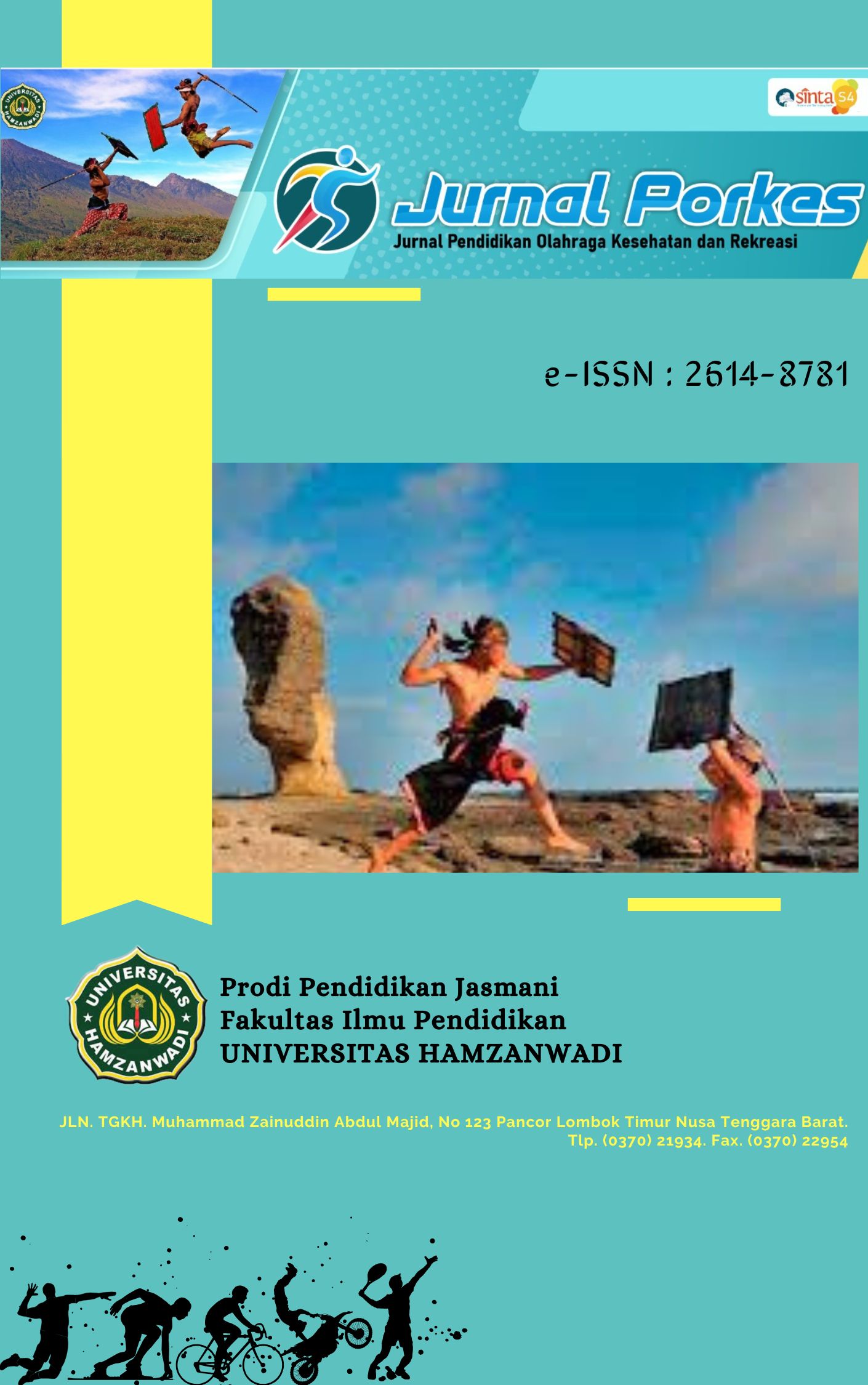Evaluating the Effectiveness of Technology in Sports Injury Prevention: A Systematic Review
DOI:
https://doi.org/10.29408/porkes.v8i2.30357Keywords:
Biomechanical analysis; artificial intelligence; sports injury prevention; injury prediction; wearable technologyAbstract
Technological advances such as wearables, biomechanical analysis and artificial intelligence (AI) offer promising solutions in sports injury prevention. This study aims to evaluate the effectiveness of these technologies in reducing injury risk and improving athlete health. This study aims to assess the role of wearables, biomechanical analysis and AI in sports injury prevention, focusing on injury risk prediction, real-time monitoring and rehabilitation. The method used was a systematic literature review by analyzing data from peer-reviewed scientific articles, conference papers, and reports published in the last decade. The focus of this review was wearable technology, biomechanical systems, and AI applications. Data searches were conducted using related keywords, and data analysis was performed qualitatively by categorizing studies based on technology type and injury prevention goals. The results showed that wearable devices such as accelerometers and heart rate monitors can reduce micro-injuries by providing real-time physiological and biomechanical data. AI systems integrated with wearables improve the accuracy of injury risk prediction. However, the effectiveness of this technology is still limited in preventing severe injuries such as ligament tears and fractures.
References
Alyami, A. H., Darraj, H., Hamdi, S., Saber, A., Bakri, N., Maghrabi, R., Hakami, K. M., & Darraj, A. (2023). Awareness of Anterior Cruciate Ligament Injury-Preventive Training Programs among Saudi Athletes. Clinics and Practice, 13(3), 656–665. https://doi.org/10.3390/clinpract13030060
Benson, L. C., Räisänen, A. M., Volkova, V. G., Pasanen, K., & Emery, C. A. (2020). Workload a-WEAR-ness: Monitoring Workload in Team Sports With Wearable Technology. A Scoping Review. Journal of Orthopaedic & Sports Physical Therapy, 50(10), 549–563. https://doi.org/10.2519/jospt.2020.9753
Boden, B. P., Anderson, S. A., & Sheehan, F. T. (2024). Catastrophic sports injuries: Causation and Prevention. JBJS, 106(1), 62–73. https://doi.org/10.2106/JBJS.23.00335
Buckthorpe, M. (2019). Optimising the Late-Stage Rehabilitation and Return-to-Sport Training and Testing Process After ACL Reconstruction. Sports Medicine, 49(7), 1043–1058. https://doi.org/10.1007/s40279-019-01102-z
Dawson, L., McErlain-Naylor, S. A., Devereux, G., & Beato, M. (2024). Practitioner usage, Applications, and Understanding of Wearable GPS and Accelerometer Technology in Team Sports. The Journal of Strength & Conditioning Research, 38(7), e373–e382. https://doi.org/10.1519/JSC.0000000000004781
Flatt, A. A., & Esco, M. R. (2016). Evaluating Individual Training Adaptation with smartphone-Derived Heart Rate Variability in a Collegiate Female Soccer Team. The Journal of Strength & Conditioning Research, 30(2), 378–385. https://doi.org/10.1519/JSC.0000000000001095
Fricke, L., Klaumünzer, A., Häner, M., & Petersen, W. (2024). New Technologies in Rehabilitation and Prevention. Sports Orthopaedics and Traumatology, 40(2), 93–102. https://doi.org/10.1016/j.orthtr.2024.04.002
Huebner, B. J., Plisky, P. J., Kiesel, K. B., & Schwartzkopf-Phifer, K. (2020). Can Injury Risk Category Be Changed in Athletes? an Analysis of an Injury Prevention System. International Journal of Sports Physical Therapy, 14(1), 127–134. https://pmc.ncbi.nlm.nih.gov/articles/PMC6350661/
Jauhiainen, S., Kauppi, J.-P., Leppänen, M., Pasanen, K., Parkkari, J., Vasankari, T., Kannus, P., & Äyrämö, S. (2021). New Machine Learning Approach for Detection of Injury Risk Factors in Young Team Sport Athletes. International Journal of Sports Medicine, 42(02), 175–182. https://doi.org/10.1055/a-1231-5304
Kaul, D., & Khurana, R. (2021). AI to detect and mitigate security vulnerabilities in APIs: encryption, authentication, and anomaly detection in enterprise-level distributed systems. Eigenpub Review of Science and Technology, 5(1), 34–62.
Kim, D., & Ko, Y. J. (2019). The Impact of Virtual Reality (VR) Technology on Sport Spectators’ flow Experience and Satisfaction. Computers in Human Behavior, 93, 346–356. https://doi.org/10.1016/j.chb.2018.12.040
Liu, L., & Zhang, X. (2022). A Focused Review on the Flexible Wearable Sensors for Sports: From Kinematics to Physiologies. Micromachines, 13(8), 1356. https://doi.org/10.3390/mi13081356
Lv, M. (2024). Construction of Athletes’ Physical Condition Monitoring and Analysis System Using Biometrics Recognition Technology. Journal of Electrical Systems, 20, 2082–2091. https://doi.org/10.52783/jes.3123
Mishra, N., Habal, B. G. M., Garcia, P. S., & Garcia, M. B. (2024). Harnessing an AI-Driven Analytics Model to Optimize Training and Treatment in Physical Education for Sports Injury Prevention. Proceedings of the 2024 8th International Conference on Education and Multimedia Technology, 309–315. https://doi.org/10.1145/3678726.3678740
Monsonís, O. B., Verhagen, E., Kaux, J.-F., & Bolling, C. (2021). ‘I Always Considered I Needed Injury Prevention to Become an Elite Athlete’: the Road to the Olympics from the Athlete and staff Perspective. BMJ Open Sport & Exercise Medicine, 7(4), e001217. https://bmjopensem.bmj.com/content/7/4/e001217
Nota, D. P. M., Bahji, A., Groll, D., Carleton, R. N., & Anderson, G. S. (2021). Proactive Psychological Programs Designed to Mitigate Posttraumatic Stress Injuries Among At-Risk Workers: a Systematic Review and Meta-Analysis. In Systematic Reviews (Vol. 10, Issue 1). Springer. https://doi.org/10.1186/s13643-021-01677-7
Orangi, M. B., Yaali, R., Bahram, A., Aghdasi, M. T., van der Kamp, J., Vanrenterghem, J., & Jones, P. A. (2021). Motor learning methods that induce high practice variability reduce kinematic and kinetic risk factors of non-contact ACL injury. Human Movement Science, 78. https://doi.org/10.1016/j.humov.2021.102805
Potthast, W. (2024). Biomechanical Data. In Sports Technology: Technologies, Fields of Application, Sports Equipment and Materials for Sport (pp. 11–18). https://doi.org/10.1007/978-3-662-68703-1_2
Rebelo, A., Martinho, D. V, Valente-dos-Santos, J., Coelho-e-Silva, M. J., & Teixeira, D. S. (2023). From Data to Action: a Scoping Review of Wearable Technologies and Biomechanical Assessments Informing Injury Prevention Strategies in Sport. BMC Sports Science, Medicine and Rehabilitation, 15(1). https://doi.org/10.1186/s13102-023-00783-4
Restrepo-Villamizar, J., Verhagen, E., & Vos, S. (2020). Defining the Individual Injury Profile of Recreational Runners: Integrating Off-Training and Subjective Factors into the Assessment of Non-Professional Athletes. In Proceedings (p. 87). mdpi.com. https://doi.org/10.3390/proceedings2020049087
Seshadri, D. R., Li, R. T., Voos, J. E., Rowbottom, J. R., Alfes, C. M., Zorman, C. A., & Drummond, C. K. (2019). Wearable Sensors for Monitoring the Internal and External Workload of the Athlete. Npj Digital Medicine, 2(1). https://doi.org/10.1038/s41746-019-0149-2
Seshadri, D. R., Thom, M. L., Harlow, E. R., Gabbett, T. J., Geletka, B. J., Hsu, J. J., Drummond, C. K., Phelan, D. M., & Voos, J. E. (2021). Wearable Technology and Analytics as a Complementary Toolkit to Optimize Workload and to Reduce Injury Burden. Frontiers in Sports and Active Living, 2, 630576. https://doi.org/10.3389/fspor.2020.630576
Shah, M., Shah, A., Patel, K., Kshirsagar, A., Sanghvi, S., & Sojitra, V. (2025). Predictive analytics, Strategic Game Analysis, and Injury Prevention in Sports: the Role of big Data and Artificial Intelligence. Machine Learning for Computational Science and Engineering, 1(1), 1–25. https://doi.org/10.1007/s44379-025-00017-z
Van Eetvelde, H., Mendonça, L. D., Ley, C., Seil, R., & Tischer, T. (2021). Machine Learning Methods in Sport Injury Prediction and Prevention: a Systematic Review. In Journal of Experimental Orthopaedics (Vol. 8, Issue 1). Springer. https://doi.org/10.1186/s40634-021-00346-x
Vellios, E. E., Pinnamaneni, S., Camp, C. L., & Dines, J. S. (2020). Technology Used in the Prevention and Treatment of Shoulder and Elbow Injuries in the Overhead Athlete. Current Reviews in Musculoskeletal Medicine, 13(4), 472–478. https://doi.org/10.1007/s12178-020-09645-9
Willwacher, S., Kurz, M., Robbin, J., Thelen, M., Hamill, J., Kelly, L., & Mai, P. (2022). Running-Related Biomechanical Risk Factors for Overuse Injuries in Distance Runners: a Systematic Review Considering Injury Specificity and the Potentials for future Research. Sports Medicine, 52(8), 1863–1877. https://doi.org/10.1007/s40279-022-01666-3
Zawacki-Richter, O., Kerres, M., Bedenlier, S., Bond, M., & Buntins, K. (2020). Systematic Reviews in Educational Research: Methodology, Perspectives and Application. Springer Nature. https://doi.org/10.1007/978-3-658-27602-7
Zhang, Y., Duan, W., Villanueva, L. E., & Chen, S. (2023). Transforming Sports Training Through the Integration of Internet Technology and Artificial Intelligence. Soft Computing, 27(20), 15409–15423. https://doi.org/10.1007/s00500-023-08960-w
Zhang, Z. (2024). Retracted Article: Quantum Sensors in Sports Biomechanics in Revolutionizing Injury Prevention. Optical and Quantum Electronics, 56(3), 311. https://doi.org/10.1007/s11082-023-06017-8
Downloads
Published
How to Cite
Issue
Section
License
Copyright (c) 2025 Andy Widhiya Bayu Utomo, Mohamad Ihsan Ashari, Kartika Septianingrum

This work is licensed under a Creative Commons Attribution-ShareAlike 4.0 International License.
![]()
Jurnal Porkes is licensed under a Creative Commons Attribution-Share Alike 4.0 International License







